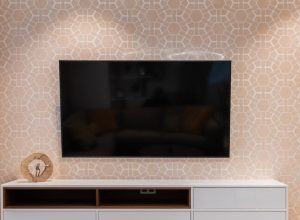There are a number of different types of TV mounts available in the market so you have to do your research to identify the best one for you.
If you don’t spend time assessing what your needs are, you may end up buying the wrong mount.
Quick summary
In this post, we will describe the different types of mounts you can get your hands on in the market and what type of purposes each type fulfills.
We’ll also go over which type of mount would be best for which type of consumer.
So without further ado, let’s get started.
Different Types of TV Wall Mounts
As you may have gathered by browsing online or maybe even in stores, there are a plethora of different categories when it comes to TV mounts.
Many of them fulfill different needs and depending on the type of living room you have, one type may be better for you than another.
Most TV mounts are distinguished from one another by the level of movement they provide.
The level of movement a mount can provide can range from no movement at all (fixed TV wall mount) to a wide variety of motion (full-motion TV wall mount).
Of course, there are many varieties in between these two types as well that offer varying degrees of motion.
Let’s have a closer look at the different types of wall mounts:
Fixed TV Wall Mount

To start off, we will discuss fixed wall mounts which are by far the most common and easy to set up wall mounts out there.
As the name suggests, they are fixed and thus, offer no motion options at all. You set it up and mount your TV onto it and that’s all you get.
While you may feel that the lack of motion options is quite restrictive, the fact of the matter is that most people don’t require a motion from their mount at all.
This is because most people just have one primary viewing position in most cases. This could be a sofa, a couch, a lounge chair, etc.
Hence, if you have a small living room and just one primary viewing position for your TV, then a fixed wall mount may be the best option for you.
Since fixed wall mounts offer no movement, even the most premium fixed wall mounts are extremely cheap.
So they can also be a great option for you if you don’t want to spend too much money on a wall mount for your TV.
Tilting TV Wall Mount

Tilting wall mounts are one step up in terms of motion from fixed wall mounts.
Most of them pretty much look exactly like fixed mounts but they have one feature that fixed wall mounts don’t: They can tilt the TV forwards and backward to adjust its viewing angle.
As you can probably imagine, this tilting function can be extremely useful for a number of different reasons.
First of all, if you miscalculate and mount your TV too high or too low, you can amend it by tilting it with the wall mount.
Not only that but if you have your TV mounted near a window or any other similar external light source, it can cause glare on your TV screen.
You can tilt your TV backward or forward with the mount in order to eliminate this glare.
Most tilting TV mounts allow you to tilt the TV up to 5 degrees backward and 15 degrees forward but in many cases, this may vary depending on the model and manufacturer.
Ceiling TV Mount

Ceiling mounts are quite special as they provide a unique aesthetic to your living room.
As the name suggests, these mounts get installed on your ceiling and they suspend your TV mid-air for you to view.
When it comes to ceiling mounts, you can choose between two different varieties: fixed ceiling mounts and motion ceiling mounts.
Fixed ceiling mounts don’t provide much in terms of motion. At most, you might be able to adjust the height of your television but that’s pretty much it. They are usually much cheaper than variable ceiling mounts.
You should opt for a fixed ceiling mount if you intend to watch TV from a single, primary viewing position such as a sofa or a lounge chair.
On the other hand, motion ceiling mounts do give you some freedom when it comes to motion. Most of them have the capability to rotate your TV a full 360 degrees.
This means that no matter where you sit in the room, you can always turn the TV around to face you. Motion ceiling mounts can be a great option if you have a larger space with multiple different viewing angles.
They can also be a great option for party spaces and event venues. Naturally, they are usually more expensive when compared to fixed ceiling mounts.
Full-Motion TV Mount

Full-motion mounts are on the opposite side of the spectrum as compared to fixed wall mounts.
As you can probably tell, full-motion mounts provide you with a ton of options when it comes to motion. They allow you to extend your TV from the wall, rotate it, and also, swivel it from side to side.
They have an articulating arm that allows you to perform all these motions. Full-motion mounts can be a great option for party spaces and large rooms with multiple different viewing angles.
No matter where you are in the room, if you have a full-motion mount, you’ll be able to position your TV in such a way that it provides the most comfortable viewing experience.
Full-motion mounts are by far the most expensive mounts you can buy on the market.
While they are often more expensive than other types of mounts, we do feel that their high price is justified due to the flexibility they provide.
If you can afford it and if you have the space to fully utilize the potential of a full-motion mount, you should definitely go for it.
We strongly recommend that you stay away from full-motion mounts if you don’t have the appropriate space to utilize them properly.
Remember that full-motion mounts can extend your TV out from the wall and move it in many different ways. If you get a full-motion mount but only have a cramped, small room to put it in, you will have just effectively wasted money.
This is because you won’t really be able to reap the benefits that a full-motion mount provides.
Other Factors to Consider

We’ve gone in-depth when it comes to the different types of mounts available on the market but there are some other factors you have to consider as well.
These factors are:
Studs or No Studs?
Most wall mounts that you’ll find in the market are designed to be installed onto walls that have studs.
Before you buy a mount, you must consider whether or not your wall has studs. You can easily determine if your wall has studs by using a stud finder.
A stud finder is a device that identifies the locations of studs behind your wall. If you don’t have a stud finder, you can also find studs behind your wall just by knocking on it.
If you’re met with a hollow sound at most locations on your wall, that means it has no studs. On the other hand, if you’ve met with a full, solid sound, that means you’re knocking on a stud.
Type of Stud
Most wall mounts you will find on the market are designed to be mounted onto wooden studs.
However, wooden studs are not the only type of studs that are used in walls. You could also have metal studs.
Before you buy a mount, identify what type of studs you have in your wall and then buy a wall mount accordingly.
Stud Spacing
Lastly, you must consider how far apart the studs in your wall are spaced from each other.
The most common stud spacing found in most American households is 16 inches.
However, the spacing can be anywhere between 8 inches and 24 inches.
We highly recommend that you identify the stud spacing before you buy a TV wall mount for your home.
Once you have identified the spacing, you can buy a TV wall mount that is appropriately designed for it.
Wrapping Things Up…
We hope you feel more confident and have a better idea of which TV mount to buy for your home now.
When you go out to buy a wall mount for your flat-screen TV, be sure to have all the factors we have discussed here in mind.
If you have any further questions, please reach out in the comments below.
Adam F.
A/V and Home Theater Expert that focuses on providing clear as well as concise reviews for anything and everything Audio Visual. From TV's, TV Mounts, Soundbars, and Wiring, my focus is to provide expertise in everything Audio Visual focused.










